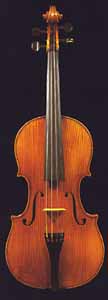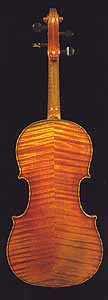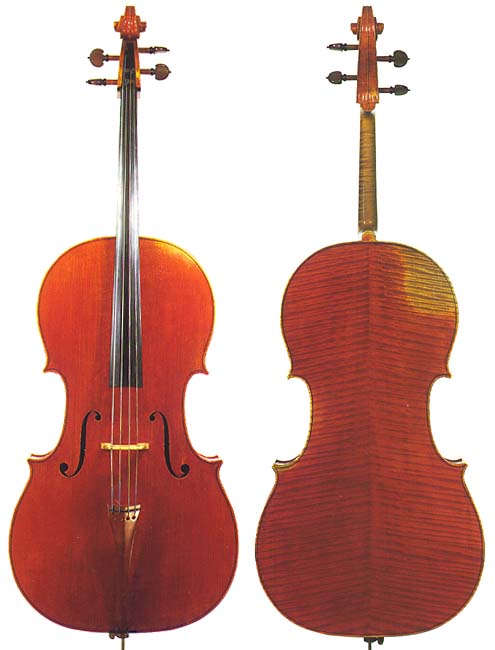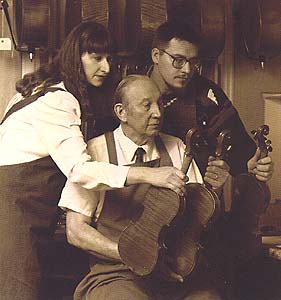




 For many professional musicians and
serious students, the search for a great instrument may be a long one. The goal is to find
an instrument that will best display one's talents. The greatest musicians most often
perform on old instruments, so it is understandable that the advancing musician is drawn
towards the dream of owning an old instrument. Certainly, the great Italian makers of the
17th and 18th centuries largely set the standards for excellence. The idea that old is
better has been accepted for many years, but in accepting this idea, the musician may miss
an opportunity to discover the fine qualities of modern instruments.
For many professional musicians and
serious students, the search for a great instrument may be a long one. The goal is to find
an instrument that will best display one's talents. The greatest musicians most often
perform on old instruments, so it is understandable that the advancing musician is drawn
towards the dream of owning an old instrument. Certainly, the great Italian makers of the
17th and 18th centuries largely set the standards for excellence. The idea that old is
better has been accepted for many years, but in accepting this idea, the musician may miss
an opportunity to discover the fine qualities of modern instruments.
Modern instruments are a desirable alternative for the musician. The present day makers are in a better position than any in the past to produce quality instruments. Examples of fine old instruments are more accessible for study and reference. There is also a greater knowledge of techniques employed by the old masters that can be applied to new construction.
At Carl Becker and Son, there exists great respect for the fine old instruments and the methods employed by the masters who created them. These instruments have endured and continue to produce exceptional tone.
The objective at Carl Becker and Son is to provide the musician with as fine an instrument today as was made 300 years ago. The Becker instrument is created with an emphasis on beauty and stability both in sound and appearance. As Jennifer Becker Jurewicz notes, "What's two years in the making when you're making it to last for centuries?"
An immense amount of deliberation has gone into designing the Becker instrument to achieve the best tone. Through observation and analysis, the Beckers believe the reason behind a great sound is physics, not guesswork. As Carl F. Becker notes, "I am fascinated by the violin from an engineering point of view-the effect of the arching and shaping on the tone." Becker also regards the graduating of an instrument as critical.
"We carefully graduate the top and back to a predetermined design, regulating the thicknesses precisely, in such a way that the instrument has the tone quality we want."
The Beckers attribute a great deal of the success of their instruments to the quality of the varnish. Carl G. Becker was fascinated with this subject at an early age. After several years, he developed a varnish that is basically the same in use today. The varnish remains tender, yet chippy in nature, similar to the character of the softer old Italian varnishes. This character allows the instrument to vibrate freely, not only when it is new, but also as it ages.
The proof of this lies in instruments dating back to the early 1900's. In the finish of the instruments, Carl Becker and Son makes no attempt to create an "antique" appearance. The mellow look of great age is allowed to develop with time and use.
By examining relatively unworn areas of Stradivarius instruments of the golden period, the Beckers concluded that the color was quite vivid when new. The vibrant quality of the Becker varnish lends rich, warm undertones to the instrument's color as it ages.
Virtually everything done at Carl Becker and Son is done intentionally - nothing is left to chance. Some makers follow the approach of using a freedom of style that results in a greater variation from one instrument to another. Carl Becker and Son respects that approach, but prefers to have definite ways of repeating a design that is meticulously planned. Consequently, instruments from Carl Becker and Son are unique within a small range of variation, ensuring a fine result.
As noted by violin dealer Charles Beare, director of J. and A. Beare Limited in London, "[The] Beckers have made an immeasurable contribution to our craft during the past 90 years, as makers of violins, violas, and cellos, and as innovative restorers, and with Jenny and Paul at the workbench, and Carl Junior still in his prime at age 72, the future is looking good.
The future is certainly what Becker instruments were always made for. Like great wines, they are good early on, but made to improve. In centuries to come, I am sure musicians will look upon Becker instruments as one of the very few outstanding makes of our era."

"When I was younger, l always said 'I want a great cello,' but I didn't have the
money. A great cello came along anyway. I have owned several Beckers and they were all
instruments of high quality. With the cost of the Strads at three million now, the day of
the new instrument is here."
Harry Sturm, former assistant principal of the Chicago Symphony Orchestra
 The Becker family
tradition making fine-quality violins, violas, and cellos began in 1901, when the late
Carl G. Becker made his first violin at age 14. The grandson of pioneer American luthier
Herman Macklett, Carl captured the passion for violin making at an early age.
The Becker family
tradition making fine-quality violins, violas, and cellos began in 1901, when the late
Carl G. Becker made his first violin at age 14. The grandson of pioneer American luthier
Herman Macklett, Carl captured the passion for violin making at an early age.
In 1902, Carl began a working relationship with John Hornsteiner. At age 18, he was entrusted with the repair of a superb Amati cello, smashed in a streetcar accident. Once restored, he crafted a replica so like the original in appearance and sound, musicians had difficulty deciding which was the copy.
This and other achievements during his 22 years with Hornsteiner earned Carl the nickname "Dr. Violin."
Carl's reputation grew steadily and in 1924, William Lewis and Son, Chicago's largest violin company, invited him to join their organization. Here, Carl became a master luthier and instrument appraiser, and started the Becker tradition of spending summers in the solitude of Wisconsin's North Woods crafting new instruments.
The Becker heritage continued in 1936 when Carl F. Becker began at age 16 to assist his father in the making of new instruments. In 1937, he joined his father at William Lewis and Son. Together, father and son began a partnership, with the son first contributing only the ribs and the rough work to his father's cellos.
After several years, a balanced division was established which resulted in a truly equal effort in their "partnership instruments." These instruments incorporated patterns and moulds of their own design, based on the concepts they observed in the instruments made by Stradivarius, Guarnerius and other fine makers. Their years at William Lewis and Son gave the Beckers the chance to study, repair and restore the great instruments of the 16th through 20th centuries. This hands-on experience taught them the secrets of fine craftsmanship, including both the aesthetics of a beautiful instrument and the physics behind superior tone quality.
The two Beckers left William Lewis and Son to form their own company, Carl Becker and Son, in 1968.
Winters were devoted to selling, restoring, repairing and appraising instruments; summers were still reserved for making new instruments.
Carl G. Becker had come to be regarded as the great American master, but he felt his son deserved this honor. Late in his life, the senior Becker said of his son, "I may have been all right in my day, but I never had the patience to spend the time that he does."
The younger Becker has indeed earned his reputation for care and craftsmanship. During 1970 and 1971, he restored the famous "Lady Blunt" violin, a Stradivarius made in 1721 that is one of the best preserved examples of Stradivarius' work. Shortly after the restoration was completed, the violin sold at auction for the record amount of $201,000.
Carl F. Becker's daughter and son, Jennifer and Paul, continued the family tradition of violin making. At an early age, Jennifer showed great interest in violin making and displayed the patience and discipline necessary for the craft. She started her first violin in 1966, at age 11 and, working part time in the summer months, completed it at age 15. At 16, she joined Carl Becker and Son full time. Benefiting from the expert tutelage of the father and grandfather and from working on the fine instruments that came in the shop, Jennifer Becker Jurewicz opened her own shop in Minneapolis in 1986 under the name of Carl Becker and Son.
Paul also inherited his father's talent as a woodworking artisan. He has made one violin of his own, which he began in 1974, at age 15, and has assisted making Carl Becker and Son instruments. He has learned many facets of violin repair and restoration and is now working full time alongside his father, managing the daily operations of the Chicago shop.
Although Carl G. Becker died in 1975, the Becker tradition continues today. Now in their tenth decade, the Beckers have made nearly 800 violins, violas, and cellos. They give special attention to each instrument they see, but they always enjoy getting a Becker original back in their shops, for each is considered an old friend of the family.
Carl Becker and Son